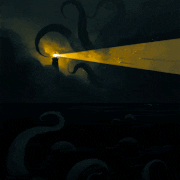|
Before there was a classical Ancient Greece that formed one of the primary sources of western thought, science and democracy, there was what is known as the Mycenaean Grecece:https://en.wikipedia.org/wiki/Mycenaean_Greece posted:Mycenaean Greece (or Mycenaean civilization) was the last phase of the Bronze Age in Ancient Greece (c. 1600–1100 BC). It represents the first advanced civilization in mainland Greece, with its palatial states, urban organization, works of art and writing system. Among the centers of power that emerged, the most notable were those of Pylos, Tiryns, Midea in the Peloponnese, Orchomenos, Thebes, Athens in Central Greece and Iolcos in Thessaly. The most prominent site was Mycenae, in Argolid, to which the culture of this era owes its name. Mycenaean and Mycenaean-influenced settlements also appeared in Epirus, Macedonia, on islands in the Aegean Sea, on the coast of Asia Minor, the Levant, Cyprus and Italy.  The collapse of Mycenaean Greece happened around the same time most other Bronze Age civilizations fell, which for many people must have felt like the end of the world. This series of events is called the Late Bronze Age collapse, a downturn in civilization similar to the post-Roman dark ages. https://en.wikipedia.org/wiki/Late_Bronze_Age_collapse posted:The Late Bronze Age collapse was a Dark Age transition period in the Near East, Aegean Region, North Africa, Caucasus, Balkans and the Eastern Mediterranean from the Late Bronze Age to the Early Iron Age, a transition historians believe was violent, sudden, and culturally disruptive. The palace economy of the Aegean Region and Anatolia that characterised the Late Bronze Age disintegrated, transforming into the small isolated village cultures of the Greek Dark Ages. One of the primary culprits for this ancient apocalpyse was a group of mysterious invaders known as the Sea Peoples, a confederation of peoples who raided all over the Mediterranean. They were as destructive and violent as Viking Berserkers, but very little is known about them. https://en.wikipedia.org/wiki/Sea_Peoples posted:The Sea Peoples are a purported seafaring confederation that attacked ancient Egypt and other regions of the East Mediterranean prior to and during the Late Bronze Age collapse (1200–900 BC). Following the creation of the concept in the nineteenth century, it became one of the most famous chapters of Egyptian history, given its connection with, in the words of Wilhelm Max Müller: "the most important questions of ethnography and the primitive history of classic nations". Their origins uncertain, the various Sea Peoples have been proposed to have originated from places that include western Asia Minor, the Aegean, the Mediterranean islands and Southern Europe. Although the archaeological inscriptions do not include reference to a migration, the Sea Peoples are conjectured to have sailed around the eastern Mediterranean and invaded Anatolia, Syria, Canaan, Phoenicia, Cyprus, and Egypt toward the end of the Bronze Age. However, recently the only remaining copy of a frieze written in ancient Luwian -- the language of a people who lived in what is now Turkey -- was found that may elucidate us on their nature: http://www.newsweek.com/mystery-lost-biblical-sea-people-revealed-ancient-hieroglyphs-uncovered-turkey-683110 posted:Mystery Of Lost Biblical 'Sea People' Revealed In Ancient Hieroglyphs Uncovered In Turkey This is what the frieze looked like:  A copy was made of the frieze before it was destroyed. While there are some questions regarding its provenance due to the reputation of the remaining copy's keeper, their disappearence involved a country known as Wilusa, which is known to us as Troy: https://www.archaeology.org/news/5975-171010-luwian-inscription-translated posted:BEYKÖY, TURKEY—According to a report in Live Science, Fred Woudhuizen, a Dutch scholar of the ancient language known as Luwian, has translated a 3,200-year-old inscription discovered in the late nineteenth century on a 95-foot stretch of stone at an archaeological site in Beyköy, a town located near Turkey’s Black Sea coast. The ancient stone, said to have been recycled in local building project, no longer exists, but a copy of the inscription was reportedly found in the estate of archaeologist James Mellaart, remembered for his excavation of Turkey’s 9,500-year-old city of Çatalhöyük. Assisted by Swiss geoarchaeologist Eberhard Zangger, Woudhuizen says the inscription describes how King Kupantakuruntas came to rule the kingdoms of Mira and Troy, and how the two kingdoms engaged in naval campaign, led by the Trojan prince Muksus, against Ashkelon. Woudhuizen and Zangger think it would have been difficult for Mellaart, who was part of an earlier translation team as an expert on the archaeology of western Turkey, to forge such a long text in Luwian. They cannot be certain that the text is authentic, however, until records of the inscription are found apart from Mellaart’s estate. It's good but also kind of weird that we know that the Troy from the Odyssey was real. Let's talk about the Late Bronze Age collapse, a sort of serious thread. That Robot fucked around with this message at 03:41 on Oct 14, 2017 |
|
|
|

|
| # ? Apr 30, 2024 14:41 |
|
tl;dr (USER WAS PUT ON PROBATION FOR THIS POST)
|
|
|
|
Iron Prince posted:tl;dr There was a dark age before there was a dark age and a mysterious group of people ended civilization as it was known then in the area.
|
|
|
|
Id like to know more
|
|
|
|
goku too easy to find 3/10 but  10/10 10/10we'll average it and say five krusts and 1.5 gokus for a reasonable 6.5/10, not bad OP
|
|
|
|
Isaac posted:Id like to know more The archaeology website links to this article for if you want to know more..
|
|
|
|
the earliest known example of a group of polities engaged in international trade and diplomatic relations exploded over the course of like half a century and because it happened a long time ago and the destruction was so complete, no one can really agree as to the why of it. and the Greek people that got murdered were the inspiration for the classical Greek myths.
|
|
|
|
|
uber_stoat posted:the earliest known example of a group of polities engaged in international trade and diplomatic relations exploded over the course of like half a century and because it happened a long time ago and the destruction was so complete, no one can really agree as to the why of it. and the Greek people that got murdered were the inspiration for the classical Greek myths. While Homer may have just been a collective name for several ancient poets, it's so weird that some parts of the old myths are real. It's neat too though.
|
|
|
|
This is really interesting. I hadn't ever heard about that frieze. I tried looking up some info about the sea people a few years ago and just got swamped with bullshit about Atlantis and aliens.
|
|
|
|
"Hey King Minos you know why they call me the bull? When I hosed your cow of a wife she gave birth to a MINOTAUR!" *Grabs crotch then goes to the town corner to get black-out drunk with my two sons named Artobyxaxanes and the other John* --- *Dies of dysentery one week later with 68% of the town's population* E: Just realized this is probably not intended to be a strict successor to the old ITT bronze age collapse thread. https://forums.somethingawful.com/showthread.php?threadid=3741026
|
|
|
|
*Furiously masturbates as I am roasted alive in a giant gold calf*
|
|
|
|
Inkfish posted:This is really interesting. I hadn't ever heard about that frieze. I tried looking up some info about the sea people a few years ago and just got swamped with bullshit about Atlantis and aliens. There's further detail here. It's an IFLscience article and it sort of looks like Vice but for science news. One guy in the article calls the whole conflict World War Zero.
|
|
|
|
That Robot posted:While Homer may have just been a collective name for several ancient poets, it's so weird that some parts of the old myths are real. It's neat too though. https://www.youtube.com/watch?v=yWnP-UdWabs
|
|
|
|
Good shot op. These "sea" "people" will no doubt return one day and it's up to us to be ready for them.
|
|
|
|
With only spooty records available from that time it's difficult to know how they made war. For example we know they used both sonic and psionic weaponry but we don't know in what ratio
|
|
|
|
SMILLENNIALSMILLEN posted:Good shot op. These "sea" "people" will no doubt return one day and it's up to us to be ready for them. I got a old cricket bat and an iron fence spike in the backyard I think I'll be OK.
|
|
|
|
Inkfish posted:I got a old cricket bat and an iron fence spike in the backyard I think I'll be OK. do deer ever get stuck on your iron spike fence? That poo poo sucks
|
|
|
|
Mumpy Puffinz posted:do deer ever get stuck on your iron spike fence? That poo poo sucks I don't think deer live here. Besides it's not in a fence it's just leaning up against the shed. Ready for me to grab should any people from the sea make an appearance.
|
|
|
|
the weird thing is that the troy from the odyssey was dated to like 1190BC and was actually troy 7, the 7th troy build on that site and it wasnt the last either
|
|
|
|
Inkfish posted:I don't think deer live here. Besides it's not in a fence it's just leaning up against the shed. Ready for me to grab should any people from the sea make an appearance. those are spears not a fence
|
|
|
|
Blue Raider posted:the weird thing is that the troy from the odyssey was dated to like 1190BC and was actually troy 7, the 7th troy build on that site and it wasnt the last either are you calling Homer a liar?
|
|
|
|
Mumpy Puffinz posted:those are spears not a fence Its definitely a fence spike I'm just using it incorrectly
|
|
|
|
Wait, so the greatest mystery in ancient history turns out to be loving Troy, the foundation of western storytelling? How does this timeline compare to expected dates of the Illiad's origination? And archeological evidence of Troy's destruction date, and the fall of the Hittite's?
|
|
|
|
Where else was there tin? How did the olden times people know where there was tin? Would a Jesse Pinkman guy just walk into the senate and get the piss beaten out of him until he told them where the tin was?
|
|
|
|
Inkfish posted:Its definitely a fence spike I'm just using it incorrectly fair enough
|
|
|
|
Horses are just beefier deer.
|
|
|
|
What's cool about the myth of Theseus and the Minotaur is how much of the story maps to archeological discoveries in Crete Bull stuff -> Reliefs and sculptures featuring bulls Labyrinth -> Maze-like palaces Man-eating monster -> Evidence of child sacrifice and cannibalism
|
|
|
|
Greeks defeated by a bunch of seamen
|
|
|
|
In the last thread I read on this the posters were somewhat skeptical because apparently the guy who owns the inscription has a really shady reputation.
|
|
|
|
Isaac posted:Id like to know more https://www.youtube.com/watch?v=Q-EOvWIGKxU&t=64s Durf fucked around with this message at 06:06 on Oct 14, 2017 |
|
|
|
Not quite Bronze Age collapse time, but still interesting:Wikipedia posted:Anemospilia was first excavated in 1979 by the Greek archaeologist Yannis Sakellarakis. The temple was destroyed by earthquake and fire around 1700 BC, about the same time as the destruction of the first palaces. The temple was found in a ruined state with stone walls only reaching hip height. Traces of ash and charcoal were found on the ground, and from this, one can postulate that the building was burnt down. Apparently a lot of archaeologists think the "knife" was just a spearhead that happened to fall down from a shelf onto the 18-year-old and that there's no evidence the platform was an altar, but come on, they totally sacrificed that kid and the gods found the sacrifice unworthy Pththya-lyi fucked around with this message at 07:15 on Oct 14, 2017 |
|
|
|
my favourite part about this is the meteoric iron some accounts of sea peoples indicate they had superior weaponry that could easily break existing swords which would have been possible only if either they knew the secret of arsenical bronze (possible) or they had access to meteoric iron that could be cold forged into/onto weapons i think its pretty badass if some poo poo falls from the sky and all of a sudden youre capable of conquering the entire 'world'
|
|
|
|
'Sea people' are actually just pirates
|
|
|
|
quote:My father, behold, the enemy's ships came (here); my cities(?) were burned, and they did evil things in my country. Does not my father know that all my troops and chariots(?) are in the Land of Hatti, and all my ships are in the Land of Lukka?... Thus, the country is abandoned to itself. May my father know it: the seven ships of the enemy that came here inflicted much damage upon us.
|
|
|
|
FuhrerHat posted:my favourite part about this is the meteoric iron fun history thing: the inuit of canada did exactly this (in the north) to the previous culture. using meteoric iron. https://en.wikipedia.org/wiki/Cape_York_meteorite 
GolfHole fucked around with this message at 06:50 on Oct 14, 2017 |
|
|
|
Pththya-lyi posted:What's cool about the myth of Theseus and the Minotaur is how much of the story maps to archeological discoveries in Crete they also had earthquake proofing for their buildings which was pretty cool
|
|
|
|
didnt egypt end up having to grant large swaths of land to the sea peoples?
|
|
|
|
I thought the Bronze Age Collapse was cause by the Daevas wars?
|
|
|
|
FaradayCage posted:Where else was there tin? That's what made the bronze age, the trade networks that allowed people to produce bronze. They broke down after the events described in the op. Interesting stuff.
|
|
|
|

|
| # ? Apr 30, 2024 14:41 |
|
FuhrerHat posted:fun history thing: the inuit of canada did exactly this (in the north) to the previous culture. using meteoric iron. you could say it was kind of inevitable, that end of this network of civilizations traded in gathered and hunted goods, primarily Amber; naturally occurring stuff and the earth's gravity would pull that junk in and the poles would exert a force that may result in more of that spacejunk going northward or southward, without good access to your pole like the northern hemisphere has doesn't give you a very good chance to pick up meteoric iron FaradayCage posted:Where else was there tin? It was mined somewhere in the Hindukush region, perhaps modern day Afghanistan according to the poo poo I read when I did my research, I wish I had some stuff to cite Former DILF fucked around with this message at 08:39 on Oct 14, 2017 |
|
|


























